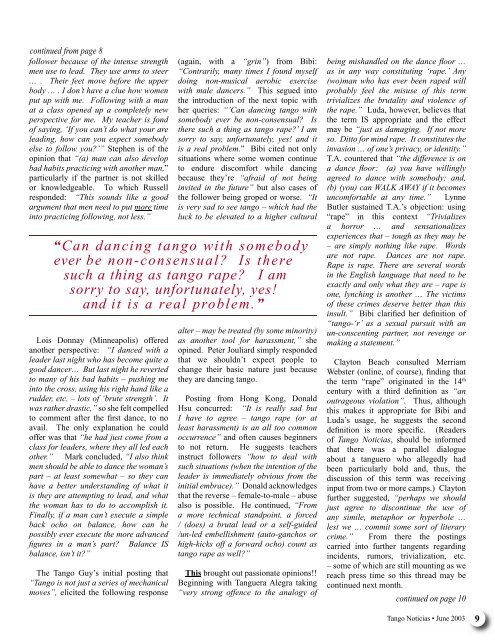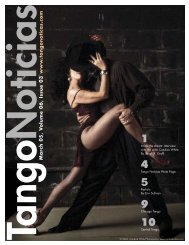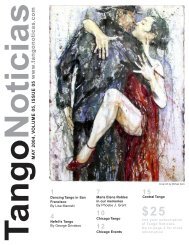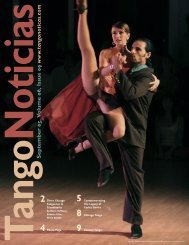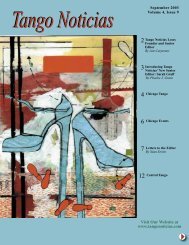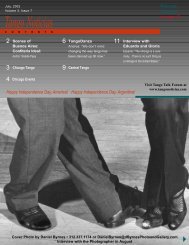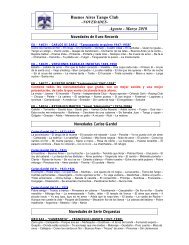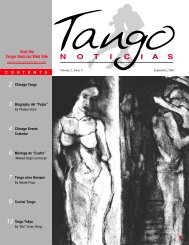LThis a regular column in TangoNoticias to review recent dialogue onTango-L & TangoATOF@yahoogroups,internet-based international forums fordiscussion of topics related to Argentinetango. The repetition in Tango Noticiasof comments posted to Tango-L or ATOFdoes not in any way constitute theendorsement of such by the editors of thispublication.TANGO-“Same-Sex Tango & Tango Rape”Summarized by Phoebe J. GrantSince the prior review columnappeared (in March 2003), a widevariety of issues have crossed keyboardsand lit up screens. Here I will addressthree and also add some relevant buteither obscure or new websites of interestto Argentine tango enthusiasts. A recentpractical exchange about the “Care offeet” relays helpful tips for our weary‘pies’. In early May, “Looking outfor each other” ensued a discussion ofwhether the term “rape” can be usedin conjunction with tango. This hadprogressed, in part from a discussion -in which two Chicago tango communitymembers were active - initiated as “Samesex dancing together” but addressingseveral tangential subjects during midto-lateApril, 2003.Taking off from a tribute to DanielTrenner (who recently relinquished thehelm of A Bridge to Tango), Daniel’ssupport of Argentine tango studentsdancing with members of the same sex(i.e., men learning to follow and womenlearning to lead) was touted. The TangoGuy – after admitting the merits of rolereversal for instruction – disagreed thatthis required dancing with a partner ofthe same sex. “Tango is not a series ofmechanical moves. It is also a danceof artistic interpretation, musicality,connection and passion which dependson the romantic and passionate feelingsbetween a man and a woman.” He thenwent on to say, therefore, that this couldonly happen between gay partners. EricJeurissen (Netherlands) vehemently andpersonally objected “after 16 years oftango-ing for fun, professionally andfanatically. … I am gay, and I dance morewith women than with men … WHAT iswrong with me??? WHAT is passion,WHAT is feeling, WHAT is this freedomif we put it to a certain shape in which weSHOULD mould it???” And our BibiWong countered The Tango Guy, with herusual tongue-in-cheek, that this meanswe each would need to “first developa romantic and passionate relationshipwith EVERY” partener before beingable to “generate artistic interpretation,musicality and connection.” Anothertanguera (Luda), however, believes that itnot only is possible but also is preferableto give yourself to your partner: “for thethree minutes while you’re on the dancefloor, you belong to that person – bodyand soul”.The Tango Guy responded that – as faras dancing tango is concerned – he is ableto have these feelings with his femaledance partners / friends “without beinginvolved or in love.” Russell Bauer(Denver) deemed The Tango Guy’sposition “A bunch of nonsense! … I canhave musicality, connection and passionwithout romantic feelings. … When I amdancing with someone (for whom I haveno) romantic feelings, my musicalityand connection doesn’t elude me. … Ihave passion for lots of things (such astennis). … (I)t does not have anything todo with … having as my doubles partnersomeone I have a romantic passionfor. I don’t see any connection betweenromantic feelings and my passion fortennis. ”Expanding on sentiments offeredby Joseph Moore, Bibi eloquentlyexpounded the topic of passion as itrelated to the music of tango. “To me themagic of tango, vs. other types of socialdancing, lies in the ability to interpretthe magical music that strikes to chordsof our senses. … If you take the time tounderstand the music, …tells stories oflove, hate, country and politics, hope,teasing, jokes and more. … Tango tome is another form of communication,regardless of the gender, age or race ofthe partner. … Many females AND maleswith whom I have had the pleasure todance could communicate beautifully. Ihave also danced with some handsomemale partners with great technicality butunfortunately we never clicked. … (O)nemay be surprised on how much our biasinfl uences our judgment sometimes.”Concurring with Russell, MichaelFigart (Houston) noted that in hiscommunity, where there is “a defi niteshortage of competent leaders,” anumber of women can be observeddancing together at most milongas andpracticas. “I can say unequivocally thatthose women who have learned to leadare among the highest quality followersin Houston. … I appreciate theirdedication, their talent, the beauty oftheir dance and the fact that it helps keepsome of the followers dancing when thereare not enough leaders to go around.And, on the other side of the coin, I’vehad great fun dancing with other men,especially during birthday dances(!!!) …I feel I can learn a lot from following, orleading, someone who usually dances onthe same side as I do.” Michael statedhis goal is to bring a follower to tears ofhappiness from his ability as a leader. “Ifit helps to dance and practice with a fewmen on the way to realizing that goal,great! Give me some more good leadersto follow!!!”Chicago’s Mark Rector agreed that“’men dancing with men’ can be a superblearning tool. … I think a good dealof bad leading habits could be brokenby men practicing with each other …because they can give very specifi cfeedback to each other – noticing detailsthat non-leaders might not even be awareof.” To which Jai (New York) added,“Not to mention details that non-leadersare all too aware of!!” Although StevenBrown (Dallas) remained “somewhatskeptical of men learning by practicingwith other men,” Michael (Washington,DC) supported Mark’s position. “Menneed to learn what it feels like to bethrown around the room or rushedthrough ochos. … I (am) glad not to be acontinued on page 9Tango Noticias • June 20038
continued from page 8follower because of the intense strengthmen use to lead. They use arms to steer… . Their feet move before the upperbody … . I don’t have a clue how womenput up with me. Following with a manat a class opened up a completely newperspective for me. My teacher is fondof saying, ‘If you can’t do what your areleading, how can you expect somebodyelse to follow you?’” Stephen is of theopinion that “(a) man can also developbad habits practicing with another man,”particularly if the partner is not skilledor knowledgeable. To which Russellresponded: “This sounds like a goodargument that men need to put more timeinto practicing following, not less.”Lois Donnay (Minneapolis) offeredanother perspective: “I danced with aleader last night who has become quite agood dancer… But last night he revertedto many of his bad habits – pushing meinto the cross, using his right hand like arudder, etc. – lots of ‘brute strength’. Itwas rather drastic,” so she felt compelledto comment after the first dance, to noavail. The only explanation he couldoffer was that “he had just come from aclass for leaders, where they all led eachother.” Mark concluded, “I also thinkmen should be able to dance the woman’spart – at least somewhat – so they canhave a better understanding of what itis they are attempting to lead, and whatthe woman has to do to accomplish it.Finally, if a man can’t execute a simpleback ocho on balance, how can hepossibly ever execute the more advancedfigures in a man’s part? Balance ISbalance, isn’t it?”The Tango Guy’s initial posting that“Tango is not just a series of mechanicalmoves”, elicited the following response(again, with a “grin”) from Bibi:“Contrarily, many times I found myselfdoing non-musical aerobic exercisewith male dancers.” This segued intothe introduction of the next topic withher queries: “’Can dancing tango withsomebody ever be non-consensual? Isthere such a thing as tango rape?’ I amsorry to say, unfortunately, yes! and itis a real problem.” Bibi cited not onlysituations where some women continueto endure discomfort while dancingbecause they’re “afraid of not beinginvited in the future” but also cases ofthe follower being groped or worse. “Itis very sad to see tango – which had theluck to be elevated to a higher cultural“Can dancing tango with somebodyever be non-consensual? Is theresuch a thing as tango rape? I amsorry to say, unfortunately, yes!and it is a real problem.”alter – may be treated (by some minority)as another tool for harassment,” sheopined. Peter Jouliard simply respondedthat we shouldn’t expect people tochange their basic nature just becausethey are dancing tango.Posting from Hong Kong, DonaldHsu concurred: “It is really sad butI have to agree – tango rape (or atleast harassment) is an all too commonoccurrence” and often causes beginnersto not return. He suggests teachersinstruct followers “how to deal withsuch situations (when the intention of theleader is immediately obvious from theinitial embrace).” Donald acknowledgesthat the reverse – female-to-male – abusealso is possible. He continued, “Froma more technical standpoint, a forced/ (does) a brutal lead or a self-guided/un-led embellishment (auto-ganchos orhigh-kicks off a forward ocho) count astango rape as well?”This brought out passionate opinions!!Beginning with Tanguera Alegra taking“very strong offence to the analogy ofbeing mishandled on the dance fl oor …as in any way constituting ‘rape.’ Any(wo)man who has ever been raped willprobably feel the misuse of this termtrivializes the brutality and violence ofthe rape.” Luda, however, believes thatthe term IS appropriate and the effectmay be “just as damaging. If not moreso. Ditto for mind rape. It constitutes theinvasion … of one’s privacy, or identity.”T.A. countered that “the difference is ona dance fl oor: (a) you have willinglyagreed to dance with somebody; and,(b) (you) can WALK AWAY if it becomesuncomfortable at any time.” LynneButler sustained T.A.’s objection: using“rape” in this context “Trivializesa horror … and sensationalizesexperiences that – tough as they may be– are simply nothing like rape. Wordsare not rape. Dances are not rape.Rape is rape. There are several wordsin the English language that need to beexactly and only what they are – rape isone, lynching is another … The victimsof these crimes deserve better than thisinsult.” Bibi clarified her definition of“tango-‘r’ as a sexual pursuit with anun-conscenting partner, not revenge ormaking a statement.”Clayton Beach consulted MerriamWebster (online, of course), finding thatthe term “rape” originated in the 14 thcentury with a third definition as “anoutrageous violation”. Thus, althoughthis makes it appropriate for Bibi andLuda’s usage, he suggests the seconddefinition is more specific. (Readersof Tango Noticias, should be <strong>info</strong>rmedthat there was a parallel dialogueabout a tanguero who allegedly hadbeen particularly bold and, thus, thediscussion of this term was receivinginput from two or more camps.) Claytonfurther suggested, “perhaps we shouldjust agree to discontinue the use ofany simile, metaphor or hyperbole …lest we … commit some sort of literarycrime.” From there the postingscarried into further tangents regardingincidents, rumors, trivialization, etc.– some of which are still mounting as wereach press time so this thread may becontinued next month.continued on page 10Tango Noticias • June 20039


